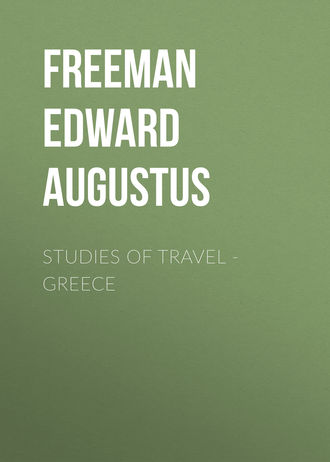
Freeman Edward Augustus
Studies of Travel - Greece
But, besides the memories of Nemea and the thoughts which it suggests, there is the temple itself. There is enough left to trace out the whole ground plan, and three columns soar above the plain, catching the eye as a prominent object in the descent. We say “soar,” for these are perhaps the only Doric columns which do soar. They are taller and slenderer than any others to be seen in Greece, and they have thereby lost much of the true Doric character. That they are of much later date than the Attic Parthenôn none can doubt. Greek antiquaries are even inclined to fix them as late as Macedonian times. One almost wonders that an architect who departed so far from the primitive Doric idea in the proportion of his columns did not venture to adopt either of the later forms of capitals, one of which at least must have come into use before his time. We have seen the Ionic capital in use on the Athenian akropolis, and it certainly would have looked more in place as a finish to the columns of Nemea than the form which seems the natural finish at Poseidônia and even at Athens. But they are grand objects all the same. Nothing can wholly take away the inherent majesty of the Doric architecture, and beside them is a relic of even greater interest than themselves. Within the precinct, built out of the remains of the heathen sanctuary, are the ruins of a small church, clearly of early date, one of the many instances in which the professors of the new faith turned the holy places of the old faith to their own purposes. A train of thoughts are suggested by the neighbourhood of the two temples, now alike equally fallen. But on this head we shall do well to check ourselves; a greater opportunity for musings of this kind will be found on the western side of Peloponnêsos.
We leave the temple; we pass by the remains of the theatre; we climb to a fountain where the women gathering around may afford a study in the varied ornaments of their dress. We pass on; we come down again, marking a number of quarries which supplied stone for the neighbouring building and which have almost the look of buildings themselves. It is to our shame that we pass by the remains of Kleônai, its akropolis covering a low hill, without stopping for a nearer examination? Such questions are not always decided by the traveller for himself; they are for the most part settled for him. And he who has lingered at Mykênê in the morning and must needs reach Corinth in the evening may be forgiven if he fail to give Kleônai her due. A halt and a meal are taken at a more convenient point, within sight of the hill of Kleônai, where a few trees give shade, and where a few ruined and forsaken houses remain as memories of the last earthquake. Of that earthquake we shall hear and see more at Corinth. We press on to the city of the two seas and the mountain crowned by its citadel. Before we reach them, we learn again at once how thoroughly Greece is a land of mountains, and how near one part of Greece is to another. Here in Peloponnêsos we see over the gulf to the mountains of Northern Greece. The hoary head of Parnassos rises before us,
Not in the phrensy of a dreamer’s eye,
Not in the fabled landscape of a lay,
But soaring snow-clad through its native sky,
In the wild pomp of mountain majesty.
There in truth it soars, as no figure of speech, but as the mountain which guarded a Pan-hellenic sanctuary greater than that of Nemea. Presently we reach a winding descent, and a flat meadow alone lies between us and Akrokorinthos. The hills of Tiryns, Mykênê, and Kleônai, the Athenian akropolis itself, are as nothing to the Larissa of Argos; but the Argive height itself yields utterly to the great Corinthian steep. Still, as yet we see only the hinder side, the land side, of the mountain; we see the highest point of the fortress which crowns it, but we do not yet see how Akrokorinthos stands to Corinth, New and Old, and to the seas on either side of it. We have yet to study one of the sites of Greece than which none is of higher interest in general history, a site which has to tell a tale of ruin, of restoration, and of renewed ruin, of a different kind from any with which we have as yet met.
Corinth
Thus far on our Hellenic journey we have been able to contrast cities which were swept away for ever in days which we call ancient with cities which have kept on an uninterrupted being to our own day. The city of the two seas, the city which guards the Isthmus, the city beside whose hill-fortresses all rival hill-fortresses seem as molehills, has a history which is unlike either, a history which, among the great cities of Greece, is wholly her own. And, as none of the great cities of Greece has seen such ups and downs of fortune as Corinth, so none has won for itself a more varied fame. There is no Greek city whose name has entered into more familiar sayings; it even sank to be a kind of a byword in very modern times. Holding, never a first, but always a high secondary place, alike in Grecian legend and in the most brilliant times of Grecian history, Corinth came to be the centre of all Grecian history in the days of the second birth of Grecian freedom; it was swept from the earth by Roman vengeance as none other of the great Grecian cities ever was; it arose afresh as a Roman colony, again under the influence of sky and soil to change into a Greek city; it kept on its Greek character through the ages of Slavonic invasion, to become one of the points most fiercely struggled for in the warfare of Turk and Venetian, to be taken and retaken by the patriots and the oppressors of yet later warfare. And now, after so long and so busy a life, after the endurance of so many blows at the hand of man, the last blow has been dealt by the hand of nature. The last of many earthquakes has sealed the doom of Corinth yet more effectually than it was sealed when Mummius swept it with the besom of destruction. Mummius simply destroyed, and what Mummius destroyed Cæsar could restore. But the last overthrow of Corinth has given her a neighbour and a rival. Old Corinth is forsaken; New Corinth has sprung up by the shore. New Corinth may well grow, and she may have ages of prosperity in store for her. But while New Corinth grows and flourishes by the shore, the only chance for Old Corinth at the foot of the mountain is that New Corinth may grow to such a degree as some day to annex the venerable site as one of its suburbs.
Those who believe in Semitic or other foreign settlements in Greece are apt, though they have no legend like those of Pelops or Kekrops to help them, to quarter a Phœnician settlement on Akrokorinthos. A name or two is all that they have to show, and a hill called φοινίκαιον, and an Ἀθήνη Φοινίκη do not prove much. No site can be more thoroughly Greek; the hill-top, near the sea, but not on it, is the ideal position for a Greek coast town of the earliest type; and at Corinth we have the mightiest of hilltops, near but not on, not one sea only, but two. It is the central point of Hellas, looking all ways, commanding her coasts and her mountains on every side. Its earliest name of Ephyrê is one scattered over many sites of central and northern Greece, from Argolis and Sikyonia to Thessaly and Thesprotia. Semitic elements may have mingled with the local worship of Aphroditê without supporting any Semitic occupation. Corinth traded with all the world, and she may have learned many things from Phœnician visitors without Phœnician settlers ever occupying her soil. The most Hellenic in its position of all Hellenic cities cannot be given up to the barbarian. Instead of a Phœnician origin, the votaries of the East must be satisfied with the most striking of Phœnician analogies. If Corinth and Carthage were not sisters in origin, they were at least sisters in destiny. They perished together, and they rose again together, if the foundation of the Roman colony can be called a rising again of either the Greek or the Phœnician city.
The old memories of far-distant Poseidônia come again on the mind — not unfittingly in a place where Poseidôn was so highly honoured — when we look on the one surviving building of the lower city. Old Corinth is now a mere village of a few houses. A few memorials of Roman times are there; but, as at Poseidônia, they have to be looked for. The one ancient building which strikes the eye and gives a character to the place is the shattered temple, where seven columns still stand in all the stern majesty of the earliest and severest Doric. Corinth gives her name to the latest, the richest, the most graceful form of architecture of Greece. But her one surviving relic is, of all buildings on old Hellenic soil, the one which is furthest removed from the character of her own order. The birthplace, so men deemed, of painting, one of the chosen seats of sculpture, a city crowded with splendid temples of later date, has now nothing to show but these half-fallen columns, carrying us back to the earliest days of the historical being of the city. Young as they seem beside the gates and vanished columns of Mykênê, the Parthenôn is young beside them. They carry us back to the days of Bacchiads and Kypselids, the days when Corinth was the mistress of the Western seas, and sent forth her colonists and artists to follow on the peninsular of Korkyra the models which she had reared at the foot of her own guardian mountain.
The columns stand over the modern village, over a site almost as desolate as that over which they must have stood in the hundred years between Mummius and Cæsar. The other fragments, Greek and Roman, hardly come into the view. But the lower city is not the true Corinth. It is the mountain citadel round which the great associations of the city gather. As we look on from far, as we climb up its steep sides, we think of the two great moments of its deliverance, the day
When first Timoleon’s brother bled,
and the night when Aratos, in his earlier and nobler days, climbed up that steep in the teeth of Macedonian guards and baying dogs, and made Corinth once more a free Hellenic city. We picture him the next morning in the agorê, leaning wearied on his spear, and telling to the citizens whom he had delivered the tale of the night’s work which had set them free. And with such a scene before us, we are not tempted to dwell on the darker day when the deliverer undid his own work, when, rather than divide the possession of Peloponnêsos with a Spartan rival, he could give back the mount of Corinth to a Macedonian lord. High indeed the mount soars above the city, as high above the Larissa of Argos as the Larissa of Argos soars above the little hill of Tiryns. Stern and bare it rises above the city; stern and bare it rises above the open land on either side. But where the mountain sinks more gently towards the lesser height on its Sikyonian side, we may climb the winding path; we may enter the gateway of the forsaken fortress; and here indeed we find the history of Corinth, the history of Hellas, written legibly in stone. The fortress which, but fifty-five years back, was so fiercely disputed between the men of the land and their barbarian masters is now a fortress only in name. The warder keeps the gate; but he keeps it only as a form. The walls shelter only ruins. But they are ruins which tell their tale, fragments which tell how
Many a vanish’d year and age,
And tempest’s breath, and battle’s rage,
Have swept o’er Corinth.
Every age, from the earliest to the latest, has left its living and speaking memorials on that memorable hill, and no classical barbarian has yet taken in hand the cruel work of wiping out that long and wondrous history. Here, in the very gateway, is a primæval wall, reared, it may well be, before Corinth was Dorian, a wall of stones such as Corinth’s own Sisyphos might have been set to roll up the mountainside. Hard by is an arch of the thirteenth century of our era, an arch, not of Venetian, but of genuine French work, work of the days when there were Latin Princes of Achaia and Latin Emperors of the New Rome. We pass on among the fortifications, the dwellings, the temples, of all the creeds and races which Corinth has seen as citizens or as masters. Here is work of Hellenic days, of days when Corinth sent forth her colonies on her one sea and met the Persian in arms on the other. Here are traces of the temples of the Roman colony, traces of the Corinth where Paul taught and which Alaric entered as the first armed disciple of Paul’s teaching. Here is the Byzantine church, witness of the long years when Corinth stood as an outpost of Christendom, in one age against the heathen Slave, in another against the Mahometan Turk. Here is the Turkish mosque, the Turkish dwelling, telling of the long struggle when the Turk wrested the fortress from the Greek, when the Venetian wrested it back from the Turk, when the Turk wrested it once more from the Venetian, till the happier day when the fetter of Hellas, the horn of Peloponnêsos, again passed into the hands of her sons. All are in ruins, all are fittingly in ruins, seeing that all are memorials of powers which have passed away. But as ruins let them be guarded and revered, as ruins which tell their tale, the tale of Corinthian and Hellenic history. The blind fury of the destroyer has decreed that the history of Athens shall no longer be read on the akropolis of Athens. Let Corinth harbour no such enemies. Let not a wall be touched, let not a stone be swept away, which still lives to tell how many times and by how many hands
Was Corinth lost and won.
The ascent is long; to any but the young and active or else the practised mountaineer it is toilsome. But the toil is broken by the relics on which we stop to gaze on our path; it is repaid by the mighty landscapes on which we gaze. It is not too much to say that we look on Hellas from its centre. The small ruined church on the height brings Akrokorinthos within the company of the sacred hills of Christendom, the hills where a sanctuary on the height looks down on town or city at its feet. Cashel has been seized by another hand as a parallel to the akropolis of Athens; a miniature more like the model is found in our own island, where the Tor of Glastonbury looks down on the battle-fields of Western England. Nearer in size however, in the mountain fittings of the landscape, are the twin hills of Sitten. But the giant alps which fence in the Rhone valley of themselves hinder the varied prospect of mountain and plain and sea and island which meets us from the hill of Corinth. The lowlier English height really comes nearer, both in effect and in historic sentiment, to the central citadel of Hellas. If the Sugarloaf, as we prosaically call it — the Pen-y-val of its own people — which so proudly guards the entrance to the Usk valley, had the castle and church of Abergavenny on its summit instead of at its foot, we should have a nearer approach than all to Akrokorinthos, though it would be Akrokorinthos without its seas. But without the seas there could be no Corinth, there could be no Hellas. The point where the Eastern and Western seas most nearly touch is in truth the centre, the key-stone as the poet puts it, of the whole peninsular land south of Olympos. From the citadel of Corinth, if all Hellas does not itself lie within our sight, yet all Hellas lies within sight, as it were, by representation. Peloponnêsos and Attica, the land north and south of the gulf, the shores of the two great confederacies, the mountains of Arkadia and of Phôkis, and the snowy head of Aitolian Korax, stand there as if to speak of the lands north and south of them. And if the Western islands, once the special scene of Corinthian enterprise and Corinthian dominion, are beyond our sight, we may pass on to them in thought along the gulf over which the triremes of Corinth were rowed to their first sea-fight with revolted Korkyra. The eastern sea opens to the right, and the curved shore of Salamis speaks of the nobler warfare where Corinth joined with Athens and with Aigina to beat back the invading lord of Asia. At some favourable moment the eye may even catch the pillared steep of the akropolis of Athens, that Athens which Corinth once hoped to see turned into a sheep-walk, but whose help she was so soon to crave against the very Sparta which held back her destroying hand. From that height the Isthmus seems but a flat plain between the two seas — the Isthmus so often fortified, so often stormed by successive invaders. By that narrow neck Agêsilaos and Antigonos, Mummius and Alaric, James of Avesnes and Francesco Morosini, Amurath and Mahomet and Ali Koumourgi have all made their way into the peninsula. But in all that long history there are two days, not far apart in so long a tale, which stand out conspicuously above all. There is the day of the Roman deliverer and the day of the Roman destroyer, the day of Flamininus and the day of Mummius. Not that it was the freedom of Greece which Flamininus proclaimed in the agorê of Corinth; such a proclamation would have been an insult to the allies of Rome and to all those Greek states which in name at least kept their freedom then and for ages after. But he proclaimed the freedom of Corinth, the freedom of all the Greek lands which the last Philip held in bondage. Fifty years later Corinth was swept from the earth; but let no man deem that even then Achaia became a Roman province. Corinth fell, Corinth rose again, to live a longer and a more varied life as the foundation of Cæsar than as the foundation of Alêtês. And those seven aged columns have stood and looked on all these changes; they beheld the reign of Periandros; they have lived to behold the reign of George of Denmark.
The Akrokorinthos is a mountain covered with ruins; the lower city has sunk to a small village. A few houses are all that remain of that busy meeting-place of two worlds; the shattered temple alone speaks of the creeds that are fallen; one mean church and another small chapel are all that are there to tell of the church which an Apostle founded. Yet the single priest of Corinth and his small flock may boast themselves that they have two epistles of the New Testament all their own, a privilege of which those few Christian households may seem more worthy than the mixed multitude of the modern Thessalonians. A night may be spent in Corinth, and that unharmed by the enemies on whom the comic poet of Athens has so grotesquely bestowed the Corinthian name. There is no fear of the δήμαρχος ἐκ τῶν στρωμάτων — no fear that the traveller may have to cry ἐξείρπουσιν οἱ Κορίνθιοι. But in Greece all animals seem to send forth louder and clearer notes than in other parts of the world; and in Corinth, the centre of Greece, they seem, though it may be merely fancy, to be louder and shriller than in the rest of Greece. A poet more recent than he whom we have so often quoted has sung of
The deep grey of the morning, when Bulgarian cocks are shrill.
Of the vocal powers of Bulgarian cocks we can say nothing; but there must just now be many witnesses either to confirm or to correct the poet’s description. But in the solitude of modern Corinth the few voices that are heard, whether of man or beast or fowl, seem certainly to sound louder and shriller even than in Athens itself. Aphroditê had one of her special homes in Corinth, though the seven massive columns are said to belong, as surely they ought to belong, to her greater sister Athênê. But the bird who once played Aphroditê so sorry a trick, and the beast which carried Dionysos and Zanthias on their journey to the lower world, call us betimes, with a power of voice which surely no Bulgarian cock could surpass, to make our way, not to Kenchreaï, but to its modern substitute Kalamaki — thence once more to draw near to Athens, this time by way of the shore of Megara and of her own Salamis.







